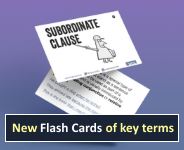Glossary: active
Explanation
An active verb has its usual pattern of Subject and Object (in contrast with the passive).
- Active: The school arranged a visit.
- Passive: A visit was arranged by the school.
Active voice is the more common pattern, which contrasts with the passive voice. In an active clause the agent is expressed as the Subject, e.g. My sister painted the fence. When an active clause is changed into a passive one, the patient becomes the Subject: The fence was painted by my sister.
Englicious contains many resources for English language in schools, but the vast majority of them require you to register and log in first. For more information, see What is Englicious?

